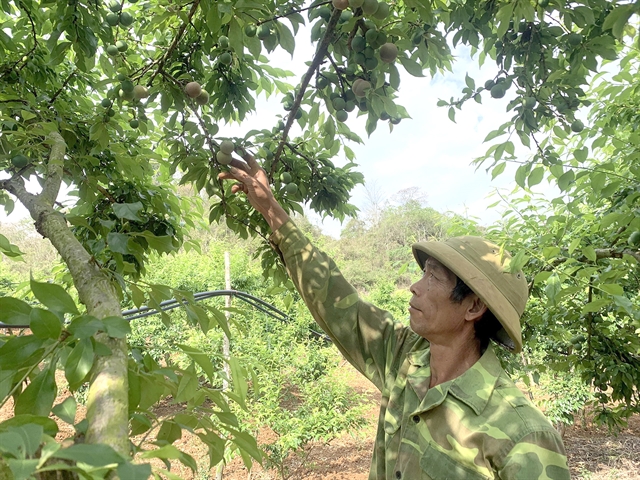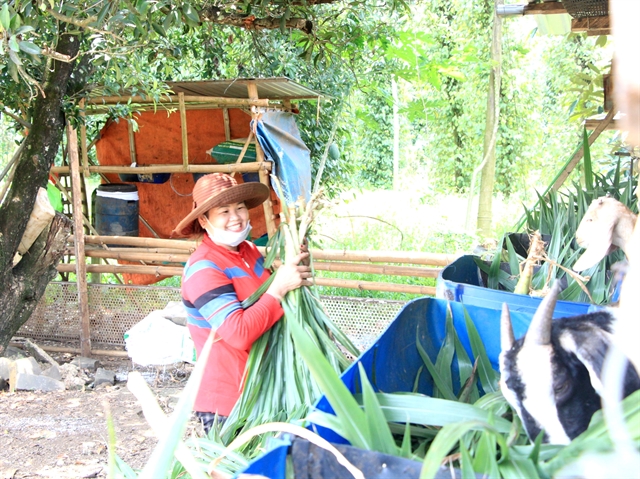 Society
Society

 |
| A farmer in his plum garden in Phiêng Khoài Commune, Yên Châu District, in the northern mountainous province of Sơn La. — VNA/VNS Photo Hữu Quyết |
HÀ NỘI — Hunger eradication and poverty alleviation programmes have helped residents escape from poverty in many localities nationwide.
Hồ Khưa, chairman of the Farmers' Association of Thanh Commune, Hướng Hóa District in the central province of Quảng Trị, cares for 500 banana trees in his garden.
Khưa, a Pa Cô-Vân Kiều ethnic minority man, said the banana tree is a key crop in an effective model of hunger eradication and poverty alleviation that 800 households applied in the commune.
Although COVID-19 meant some exports were suspended over the past two years, his family still earned hundreds of millions of đồng each year from bananas, he said.
Khưa also said his family was the first household in the commune to plant rubber trees according to the district's policy.
He has harvested latex from his 2ha rubber tree garden and earned money.
He also grew another 2,500sq.m of solanum procumbens lour recently, a medicinal plant that could bring better income for his family.
Khưa's farm is becoming a good example for ethnic minorities in the region to learn experiences.
In the northern mountainous province of Sơn La, thanks to the implementation of poverty reduction programmes, Phiêng Khoài Commune has become the "kingdom of plum" instead of poor and sparse forests like before.
Tráng Lao Khai, head of Lao Khô 1 Village, Phiêng Khoài Commune, Yên Châu District, said the lives of farmers have become much better after shifting to growing plum trees.
The commune already has millionaires and billionaires, he said.
Government's efforts
In recent years, despite many natural disasters and the COVID-19 pandemic, the Government still doubled investment resources for poverty reduction compared to previous periods.
The investment resources for poverty reduction account for 21 per cent of the State budget, the highest rate in the Association of South East Asian Nations (ASEAN).
Việt Nam has early completed the Millennium Development Goals of the United Nations on hunger eradication and poverty reduction and is considered by the international community as a bright spot for poverty reduction in the world.
Statistics from the Ministry of Labour, Invalids and Social Affairs show that the national poverty rate has fallen from 58.1 per cent in 1993 to 2.75 per cent in 2020 and 2.23 per cent in 2021.
When the COVID-19 pandemic has greatly affected labour, employment and social security issues, posing a risk of falling into poverty for many people, the Government has issued many measures to ensure social security, including a policy to directly support 13 million people affected by the pandemic, focusing on the poor and unemployed.
On October 10, 2021, the Government issued Resolution No. 128/NQ-CP on safe and flexible adaption to and effective control of the COVID-19 pandemic. The resolution is believed to contribute to stopping the risk of labour supply chain disruption.
Localities have spent a total budget of VNĐ83.7 trillion (US$3.4 billion) to support 50.8 million labourers and other people affected by the pandemic in the country.
In a related movement, at the beginning of this year, Prime Minister Phạm Minh Chính approved the National Target Programme for Sustainable Poverty Reduction in the 2021-25 period.
The programme is designed to focus on improving the capacity of the poor; identify the causes of poverty to radically and thoroughly solve the problems.
The total capital for the programme's implementation in the period is estimated to be at least VNĐ75 trillion ($3 billion), including VNĐ48 trillion ($1.95 billion) from the central budget and VNĐ12.6 trillion ($514 million) from the local budget.
Minister of Labour, Invalids and Social Affairs Đào Ngọc Dung said that the programme's overall goal was to achieve sustainable poverty reduction, limit re-poverty and support poor households to access basic social services and improve their life quality.
The programme sets annual targets that the rate of poor households will decrease by 1-1.5 per cent, ethnic minority poor households by 3 per cent, and households in poor districts by 4-5 per cent. In the whole period, 30 per cent of poor districts and 30 per cent of communes with special difficulties will get out of poverty.
The Secretariat of the Communist Party of Việt Nam has issued a directive on strengthening the leadership of the Party for sustainable poverty reduction by 2030, so that by 2030 there will be no poor districts or communes in the country, as well as successfully achieving the goal of reducing the multidimensional poverty rate of 1-1.5 per cent each year following the Resolution of the 13th Party Congress.
The directive identifies sustainable poverty reduction as a major and consistent policy of the Party and State; an important, regular and long-term task of the whole political system and society, to constantly improve the people's material and spiritual life.
 |
| A woman in Phước Minh Commune, Bình Phước Province feeds her goats, which she bought with borrowed money from the Vietnam Bank for Social Policies, to earn living and escape from poverty. — VNA/VNS Photo |
Challenges still ahead
However, Việt Nam still has nearly 2.4 million poor and near-poor households, around 9 per cent of the country's population.
At the 14th National Assembly, the Government sent to the National Assembly a report on the six-year implementation of the Resolution No. 76/2014/QH13 of the National Assembly on accelerating the implementation of the goal of sustainable poverty reduction.
The report shows that the poverty reduction results of Việt Nam are not sustainable. It was easy for people to fall into poverty, and the gap between rich and poor among regions and population groups has not narrowed. The poverty rate is still above 50 per cent in many places.
The poverty rate of ethnic minority households is still high. The income standard in the poverty line is currently only 45 per cent of the minimum standard of living. In addition, the report said several mechanisms and policies specific to poor areas, mountainous areas, and ethnic minority areas had not been implemented effectively.
The phenomenon of profiteering of poverty reduction policies still occurs. For example, in 2020, 12 officers in two communes of Quý Hòa và Tân Lập in Lạc Sơn District, Hòa Bình Province were found having names in the list of poor and near-poor households to receive financial support from a social security package of the Government while the package is designed only to support disadvantaged people affected from the pandemic. — VNS